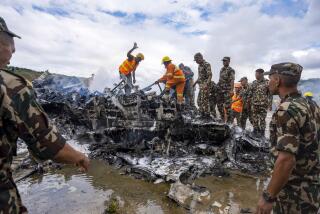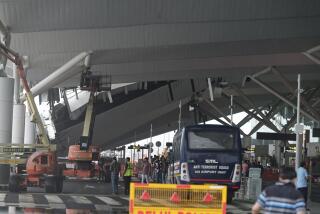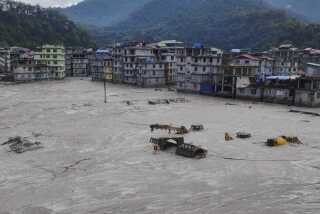India rescue chopper crashes in flood zone, killing eight people
NEW DELHI -- An Indian rescue helicopter crashed Tuesday evening, killing eight people, the air force said, as the official death toll in flood-besieged northern state of Uttarakhand rose to more than 820 people.
The newly acquired Russian-made Mi-17 V5 helicopter was returning in inclement weather from Kedarnath, the heart of the devastated area, when it crashed, officials said. Some media reports, citing government sources, said the death toll could be higher given that the aircraft was capable of carrying as many as 30 people.
Massive rain-induced flooding hit the state June 15 just as tens of thousands of Indian pilgrims and tourists were trekking to remote temples in mountainous Uttarakhand for a religious festival. The ensuing landslides and raging rivers wiped out hundreds of houses, roads and bridges, and even entire villages, in a crisis dubbed the “Himalayan tsunami” by local media.
With the discovery of 127 bodies Monday, the official death toll now stands at 822, although some say it could go significantly higher given that large swaths of territory have not been reached by recovery crews.
After the weather improved late last week, another storm rolled in Monday, impairing efforts to rescue the estimated 6,000 people still stranded without food or warm clothes.
The chopper that crashed was one of 80 Mi-17 V5’s ordered from Russia last year. The military has called for an inquiry into the accident but said airborne rescue operations would continue.
“Our helicopter rotors will not stop churning till such time as we get each one of you out,” said Air Chief Marshal Norman Anil Kumar Browne on Monday. “Do not lose hope, and hang in there.”
Five of the eight people aboard the helicopter were crew members, squadron leader Priya Joshi told reporters in New Delhi. It wasn’t immediately clear whether the aircraft was carrying flood victims or only rescuers.
Some 10 days into the disaster, authorities are increasingly worried about a possible epidemic, spurring a massive effort to expedite the cremation of hundreds of bodies after identification, postmortems, DNA collection and mass funeral ceremonies. Along with blankets and food, helicopters have been ferrying in to the disaster area large quantities of wood and ghee, clarified butter that Hindus believe assuages the spirits.
While the military has won plaudits for its rescue work, government agencies have come under sharp criticism for their poor preparation, slow response and weak coordination. Despite being susceptible to severe weather, Uttarakhand lacks a Doppler radar, reportedly because turf-conscious bureaucrats argued over the purchase.
“The National Disaster Management Agency has been a disaster,” said Ramesh C. Chopra, a corporate and strategic advisor and former army major general. “These treks have been happening for years and years. By now they should realize something like this should happen.”
A report two months ago by India’s national auditor said that the state had virtually no disaster management plan and that its management team had not met since 2007. “The state authorities were virtually non-functional,” the report said.
Analysts said greed also has infused the annual religious pilgrimages to Uttarakhand, leading to unfettered building of poorly constructed hotels along steep river banks that quickly washed away when water levels rose.
In recent days, the rescue effort has turned political. The ruling Congress Party was slow to respond, with heir-apparent national leader Rahul Gandhi only touring the disaster area a week after flooding started.
Sensing an opening, controversial opposition leader and Gujarat Chief Minister Narendra Modi claimed he had rescued 15,000 people in his state, only to be slammed by critics for playing “Rambo” and milking the tragedy for political purposes.
Analysts said the crisis contained many lessons that probably wouldn’t be learned.
“Rather than blaming each other to score brownie points, the politicians should be helping,” Chopra said. “We’re very good at planning but fall short on implementation, and you can see the result.”
ALSO:
Qatar ruler abdicates, hands power to his son
Taliban gunmen launch attack near Afghan presidential palace
Moscow rejects U.S. pressure over Edward Snowden; eyes on Belarus
Tanvi Sharma in the Times’ New Delhi bureau contributed to this report.
More to Read
Sign up for Essential California
The most important California stories and recommendations in your inbox every morning.
You may occasionally receive promotional content from the Los Angeles Times.










